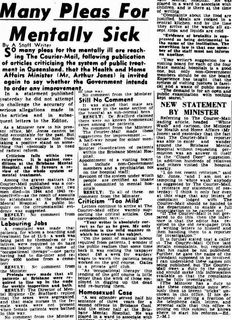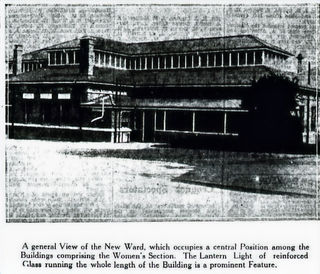

There Was Once an Asylum



This site not only provides an overview of mental health history and its implications for Goodna, but also explores the complex relationship between memory and history
There are stories we may never know, but this site uncovers the history, revealing the layers of understanding that form the foundation of the present.
It is done in a way that honours the patients, clients, and the people.
Media Collection
Collection of media stories from over the years covering the complex
John Tones 1823-1886: video biography
Goodna Girls
Goodna Girls tells the story of children incarcerated in Wolston Park Hospital, an adult psychiatric facility in Queensland. It contains the personal testimonies of women who relate—in their own no-holds-barred style and often with irreverent humour—how they, as children, ended up in Wolston Park and how this affected their adult lives.
Goodna Girls
A History of Children in a Queensland Mental Asylum' by Dr Adele Chynoweth FHEA OAM
Father Wally Dethlefs
Father has dedicated his life to working with underprivileged young people, giving voice to the unheard and powerless youth of Brisbane through compassionate conversation and support. Father Wally was a confidant and counsellor to some of the young people who were former patients at the Goodna Mental Hospital. He was a contributor to the Museum's hard hitting exhibition Remembering Goodna: Stories from a Queensland mental hospital.
ABC News 2024
An investigation into a mental health facility at the centre of historical abuse allegations has been welcomed by former staff, patients and their loved ones after decades of advocacy. Brisbane's Wolston Park Mental Hospital closed in 2001, but it has been the subject of a barrage of allegations of sexual abuse, beatings and chemical restraint. Queensland Health Minister Shannon Fentiman has announced the Mental Health Commission will investigate the health services provided at Wolston Park between the 1950s and 1990s.

Behind the Walls of the World’s Psychiatric Hospitals
Ep. 68: History of Goodna Mental Hospital, Part 1 (1865-1936)
1999 Forde Enquiry Apology

How one bloke’s boozy night out ended in an asylum
Way We Were: Inside Brisbane’s most notorious lunatic asylum
Sunday Mail Story
A Queensland shepherd on a bender ended up in one of Brisbane’s most notorious lunatic asylums and nearly wasn’t released.
There was nothing pleasant about the hot and crowded Brisbane Gaol on Petrie Terrace in 1868 but for many, it was infinitely preferable to the horrors of the Woogaroo Lunatic Asylum at Goodna. The asylum, which had opened only three years earlier, was already controversial when Thomas White decided to go public with the sorry tale of his eight weeks in Woogaroo. Like other inmates, he was not a lunatic but had gone on a bender and was picked up suffering delirium tremens: “I had earned a heavy check out north; I spent it before I reached Rockhampton, and from the bench in that town got sent to Woogaroo.” He was shipped off to Brisbane Gaol for a week and then on to the asylum at Goodna where he arrived in October 1868, sober and sane. When he finally won his release, he didn’t hold back, detailing his experience in a long letter to the Brisbane Courier in February 1869, and noting the contrast in his treatment and that of criminals. White, a shepherd at Cressbrook, wrote that if the public thought Woogaroo was more comfortable for an insane patient than Brisbane Gaol, it was a gross delusion. On arrival, he was ordered to strip and wash in a tub of filthy water where inmates had washed their muddy feet. The water was changed only once a day, but “in Brisbane gaol, a man can stretch himself in a bath and luxuriate there as long as he likes, and at any time of the day he pleases.” The food was stale bread, tea that tasted of neither tea nor sugar, “In Brisbane Gaol if a man’s own mind will let him sleep, he may, he has the cell to himself, but in Woogaroo lunatics are packed as close as they can be in the room, and many of them talk and walk all night.” The asylum’s unventilated hospital was worse: “they evidently came there to die; I never saw one leave it, except in his coffin.” and potatoes that were scarcely edible served from filthy pots. At the Goal, he had received the bread of the best quality, and clean utensils.
Every cell in Brisbane Gaol had reading material, but in Woogaroo there was nothing.
One man was reported dead and put straight into a coffin. Some of the patients cried out he was alive and having a fit. When the chief warder was told that the body was still warm and that patients were creating a row about him being buried alive, his reply was to go and nail it down.
A sick man in Brisbane gaol was confined in a bed with clean sheets in a well-ventilated room, not on two planks nailed together on the ground. The biggest difference though was that a stay at Woogaroo was indefinite – release was at the will and whim of one man – and that man, the surgeon superintendent Dr. Kearsey Cannan, was not in the habit of assessing inmates. A former gaol medical officer, Dr. Cannan had been appointed when Woogaroo opened in 1865. His management was questioned at an inquiry in 1867 and shocking stories about conditions had continued. It was this ongoing public attention that saved White, who attributed his release to the power of the press.
“That lion, the press, began to growl about Woogaroo,” he wrote. “Oh, the glorious press!”.
On Thursday, November 26, he was shown into the doctor’s office, and “the gentleman, who for seven weeks would not deign to answer me by one single word, conversed with me in a friendly and affable style. “He told me he would send for my discharge and that he really thought I had no business to be sent there.” White was released days later. He requested the return of his swag and possessions but got nothing.
“When a prisoner enters a common gaol, his clothes are washed and set aside for him and restored when he gets his freedom.
Not so at Woogaroo. He leaves it without a penny in his pocket.”
White’s report added to the public outcry which had been bubbling for months, resulting in two inquiries in 1869.
In May, Dr. Cannan was held responsible and with his chief warder was dismissed.
The second inquiry identified failures, insufficient accommodation, and incompetence. The light began to penetrate Woogaroo, “a mysterious dark place since it was first inhabited”. Henry Challinor, a trusted GP was tasked with straightening out the scandal.
By the end of the year, improvements were underway but within a decade reform was back on the agenda and a Royal Commission was established in 1877.




























